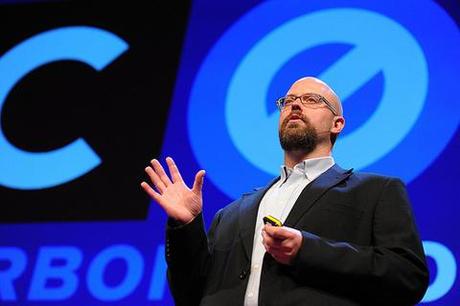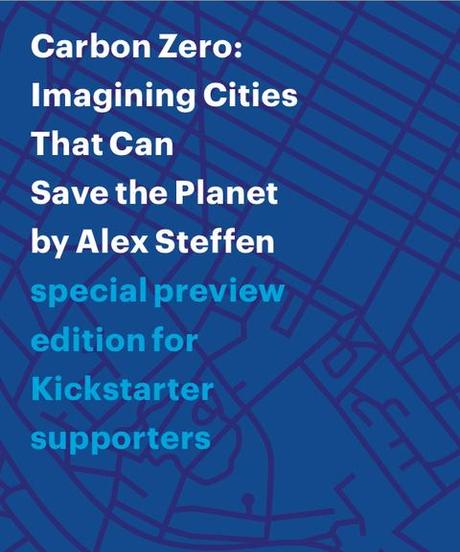
Alex Steffen speaking at a TED conference. Photo courtesy of TED Conferences.
Q & A
You're a massive proponent of cities. Yet if I want a truly green and more natural lifestyle shouldn't I move back to the land?
Maybe a little cabin in northern Maine to do some pickling? Twentieth century environmentalism was about behavior, but the key to 21st-century sustainability must be found in systems. Everything we do is made possible by larger systems, and it is at the level of those systems that we generally have the biggest negative impacts, so that's where we need to innovate.
By moving to Maine you may do some good things by, for instance, reducing your food impacts by gardening and learning to pickle, as you suggest. Truly rural lives based on local self-sufficiency and sustainable stewardship of land and natural systems have their place.
But a huge number of people move to the country and act like they live in the suburbs, just with bigger lawns. If you live in a 3,000 square foot house at the end of a long road, drive your hobby truck around and buy a lot of stuff to stock up your rural lifestyle, you quite likely have a much greater ecological footprint than you would back in a city. That's even more the case if you actually live in the city most of the time and have a country place as your second home, or you're a hypercommuter driving many hours a week on a regular basis. You may feel green when you're boiling jar tops, but your lifestyle floats on a giant cloud of emissions.

Alex Steffen's new book, Carbon Zero.
In your book Carbon Zero, you say that cities can help us get to much lower carbon emissions. How can they do that? And why are they uniquely positioned to do so?
Cities can do three things phenomenally well: They can put us closer together with the things we want to do; they can provide affordable opportunities to build more sustainable systems; and they can create cultures of sustainable innovation.
Cities bring things closer together, and proximity lets us take on the problem of the car. If we're honest about assigning responsibility for the emissions caused by our consumption, cars and auto-dependent lives show themselves to be the biggest cause of North Americans' (and Australians') oversized carbon footprints. We know that by combining more compact development with more walkable streets and investments in transit, cities can shift the whole system of transportation to one with much lower emissions. Even if you like having a car, if you live in a much more walkable, dense city, your choices will change and your emissions will likely drop.
Urban systems are inherently more efficient than systems in sprawling suburbs. It's not hard to figure out why: If one two-mile stretch of road serves 5,000 residents in a city, but only 200 houses in a suburb, the urban road has a much lower impact per person than the suburban road. The same is true for water pipes, power grids, sewer systems, emergency services, and so on. All these things also cost much more to deliver in sprawling suburbs, which makes it very difficult to upgrade to better-performing alternatives. Cities, though, have the tax base and number of residents to make building newer, better infrastructure (from transit to smart grids to green streets) affordable.
Finally, there's innovation. We face an interconnected set of crises involving climate change, global poverty alleviation and urbanization, energy availability, resource depletion and ecosystem collapses. To make it through this planetary crisis, we need fundamental changes in the systems we depend on to provide prosperity. All that change, though, is not just a challenge, it's a giant opportunity. Regions that respond boldly enough will be more rugged in the face of climate and economic disruptions, but also thrive as their capacities for reinvention create zero-carbon skills, solutions and industries. With billions of people moving to (or being born in) cities over the next 40 years—all of them facing the same interlocking crises—the market for sustainable prosperity is almost unfathomably huge.
The one thing the solutions we need all have in common is urbanism. All of the systems causing this crisis (like energy, agriculture, and manufacturing) are already either urban systems, or exist increasingly to feed urban systems. The best way to find replacement models for what's broken is by understanding the new possibilities of cities, and you simply can't understand those now if you don't live in a city. And when cities become hotbeds of thinking about innovations, they tend to produce non-linear results: all those folks rubbing elbows come up with things they never would have on their own. In fact, I think there's an opportunity for a few cities to seize leadership in sustainable urbanism and to create whole new business models on a scale we find difficult to grasp, now.
What are these new green neighborhoods, these Eco Districts you mention in your TED talk? Where are they and what are they doing that can be emulated elsewhere?
Ecodistricts are all over the place now, with the most famous being places like Vauban in Freiburg, Hammarby Sjöstad in Stockholm and the Western Harbor in Malmö. Almost all of them are essentially new neighborhoods that share the approach of trying to integrate more sustainable systems into the districts from the ground up, starting with clean energy, green buildings, shared streets and so on. Since all these solutions tend to reinforce each other, Ecodistricts offer the terrific opportunity of creating virtuous cycles from the beginning. Where cities have really large areas of vacant land, building an ecodistrict ought to be the first thing they explore.
But most thriving North American and European cities have limited opportunities for this kind of from-scratch development. In most places, we're talking less of blank slate and more a task of reweaving and introducing new elements. Much can be done with infill development, district infrastructure retrofits, and street upgrades. The results can be profound, but it isn't simple work.
How dense is too dense for cities? I know you champion infill and smart urban interventions, but at what point in enlightened urbanization do we lose the soul of a place? Could LA be LA if had the population of New York? What happens to San Francisco if it gets even another 200,000 residents?
I'm not sure we've seen anywhere that's "too dense" in a North American city, especially if part of our criteria is people's desire to live there. The densest places in the U.S. generally have the highest property values. Certainly there are tens of millions more people who want to live in walkable urban neighborhoods than there are urban homes to house them in.
But you're also referencing one of the great myths in urbanism: that existing cities are "built out." They're not. Almost every city in North America has big patches and swathes of sprawling auto-dependence, not to mention abandoned buildings, brownfields, and parking lots. Transform those into compact, walkable hubs and corridors, and adding many more residents improves the quality of life. If you do focused development right, and bake in lots of housing in green buildings, historic preservation, walkability, bike lanes, transit and parks, neighborhoods can become much better, more welcoming, and more affordable places than they'd otherwise be. We can take the least-loved, least-sustainable places in our cities and start there. Start with the tear-downs, the strip malls, and the surface parking lots. In low-density neighborhoods, make backyard cottages, additions and basement granny flats easy to build. Fast-track good infill. Reclaim excess road lanes and plant trees to create public space like parklets and plazas. There's lots of space there in our cities.
Obviously, whether the character of a neighborhood is enhanced in that process is largely an individual judgment call. But not all judgments are equal. Anyone who defines their neighborhood's character, for instance, in terms of securing on-street parking, preserving private views, or excluding renters (the most common NIMBY complaints) doesn't have much to add to the debate, in my opinion. And when it comes to opposing transit, compact development, and walkability, well, if a community's character really depends of continuing ways of living that are melting the ice caps, I'd question whether preserving that character is even an ethical thing to do.
You helmed World Changing for ages. Where do you get your green news now? Any sites or publications that are really smartly beating the sustainability drum?
There are really too many to list now. Things seem to have hit a breakthrough velocity, and in almost every field there are at least a handful of great blogs focused on covering the very edge of zero-carbon/sustainable innovation. I try to note the best things I find on my own Twitter feed, but it really is drinking from a fire hose now. In fact, the passion and creativity of the mostly young folks at the center of all this is one of my main sources of inspiration. There's a movement of folks out there ready to remake their cities to help save the planet, and they're everywhere, on every continent, in every city. A lot depends on them succeeding.
